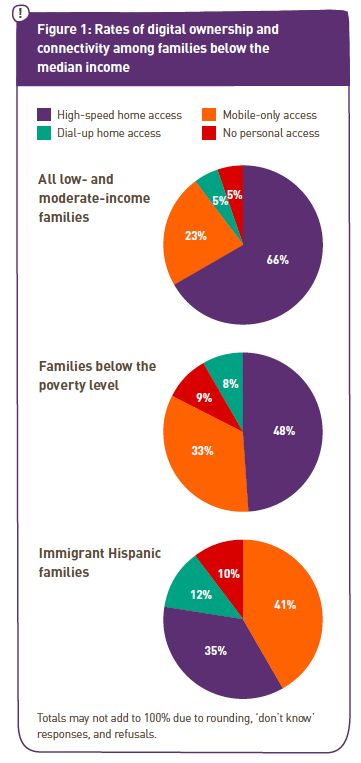 As smartphones, tablets and cheaper computers have entered the market, the modern digital divide appears to have shifted from having any Internet access to providing high-speed connections to the web. A new report released Wednesday highlights many of the realities facing those families with young children who are on the lower half of the nation’s income spectrum and offers some key things for game developers to consider.
As smartphones, tablets and cheaper computers have entered the market, the modern digital divide appears to have shifted from having any Internet access to providing high-speed connections to the web. A new report released Wednesday highlights many of the realities facing those families with young children who are on the lower half of the nation’s income spectrum and offers some key things for game developers to consider.
The report notes that it is no longer a question of any connectivity – some 94 percent report Internet access in the home – but really the quality of that access. Many families report slower speeds and some 30 percent said that they often maxed out their data plans. But still, the findings paint a different world than the old days of a digital divide between the haves and have nots.
Co-author and researcher Victoria Rideout told USA Today that the digital divide may have been bridged, but “It’s just a little bit rickety of a bridge… What we’ve learned is that whether or not a family has Internet access is no longer a simple black-white, yes-no type of a question, because all Internet access is not created equal.”
 The report, “Opportunity for All? Technology and Learning in Lower-income Families,” was funded by the Bill & Melinda Gates Foundation and produced by the Joan Ganz Cooney Center. It was issued during a day-long conference on digital inequity in Washington, D.C.
The report, “Opportunity for All? Technology and Learning in Lower-income Families,” was funded by the Bill & Melinda Gates Foundation and produced by the Joan Ganz Cooney Center. It was issued during a day-long conference on digital inequity in Washington, D.C.
The conference brought together federal officials, activists and scholars to discuss what the modern digital divide looks like and what the impact of digital inequality may mean. The meeting included a presentation of the information as well as comments from the chairman of the Federal Communications Commission, Tom Wheeler.
“It has been 150 years since we have seen the kind of impact a network can have that we are seeing now with the Internet and particularly the wireless Internet… Now what are we going to do about it?” Wheeler asked the conference. “What are we going to do about it to address the challenges of America? If we live through this period of incredible network transformation and don’t use the power of that network to also transform opportunities and society, shame on us.”
The new report highlights that many families and their children may not be able to fully take advantage of the power of a connected world due to slow and limited access to the Internet.
The researchers surveyed more than 1,100 families with children between the ages of 6-13, with household incomes below $65,000 per year.
Key Findings
- Among families who have home Internet access, 52% say their access is too slow, 26% say too many people share the same computer.
- 10% immigrant Hispanic families have no Internet access at all, compared with 7% of U.S.-born Hispanics, 5% of Whites, and 1% of Blacks.
- Among all 6-to 13-year-olds who use computers or the Internet, 81% use them to play educational games.
- 91% of families own a mobile device (smartphone or tablet), 81% own a computer (laptop or desktop)
So, what should developers have in mind about these findings?
- First, the ability to reach nearly all families now exists, but access does not mean the same thing in all families.
- Developers should keep in mind there are millions of potential users who may need to be careful about Internet and data usage on their mobile devices for fear of overages.
- Mobile devices are the dominant way in which lower income families access the Internet and so desktop applications are inaccessible to some 19 percent of lower income households.
- Developers may want to consider ways to reduce the download size of applications to ensure families with smaller data plans do not opt out of their products.
The other thing to consider is the fact that kids are often going to have limited access to a single family device with Internet access, a fact Rideout said may limit the impact of access on kids’ academic lives. She told KQED’s Mindshift, ““What’s it really like to do your homework on a smartphone you’re having to borrow from your mom, but she needs it for something else? Are you really able to do your research paper?”
